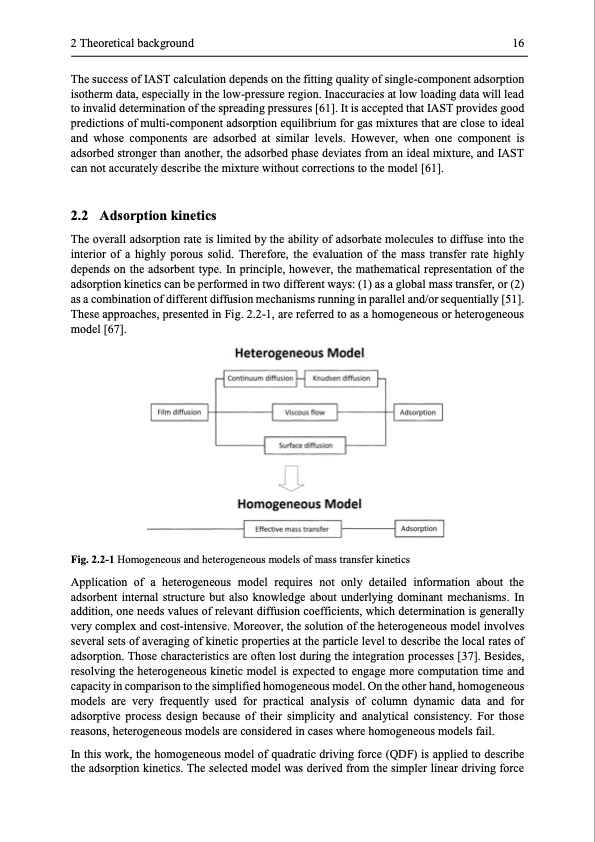
PDF Publication Title:
Text from PDF Page: 029
2 Theoretical background 16 The success of IAST calculation depends on the fitting quality of single-component adsorption isotherm data, especially in the low-pressure region. Inaccuracies at low loading data will lead to invalid determination of the spreading pressures [61]. It is accepted that IAST provides good predictions of multi-component adsorption equilibrium for gas mixtures that are close to ideal and whose components are adsorbed at similar levels. However, when one component is adsorbed stronger than another, the adsorbed phase deviates from an ideal mixture, and IAST can not accurately describe the mixture without corrections to the model [61]. 2.2 Adsorption kinetics The overall adsorption rate is limited by the ability of adsorbate molecules to diffuse into the interior of a highly porous solid. Therefore, the evaluation of the mass transfer rate highly depends on the adsorbent type. In principle, however, the mathematical representation of the adsorption kinetics can be performed in two different ways: (1) as a global mass transfer, or (2) as a combination of different diffusion mechanisms running in parallel and/or sequentially [51]. These approaches, presented in Fig. 2.2-1, are referred to as a homogeneous or heterogeneous model [67]. Fig. 2.2-1 Homogeneous and heterogeneous models of mass transfer kinetics Application of a heterogeneous model requires not only detailed information about the adsorbent internal structure but also knowledge about underlying dominant mechanisms. In addition, one needs values of relevant diffusion coefficients, which determination is generally very complex and cost-intensive. Moreover, the solution of the heterogeneous model involves several sets of averaging of kinetic properties at the particle level to describe the local rates of adsorption. Those characteristics are often lost during the integration processes [37]. Besides, resolving the heterogeneous kinetic model is expected to engage more computation time and capacity in comparison to the simplified homogeneous model. On the other hand, homogeneous models are very frequently used for practical analysis of column dynamic data and for adsorptive process design because of their simplicity and analytical consistency. For those reasons, heterogeneous models are considered in cases where homogeneous models fail. In this work, the homogeneous model of quadratic driving force (QDF) is applied to describe the adsorption kinetics. The selected model was derived from the simpler linear driving forcePDF Image | Modelling and Simulation of Twin-Bed Pressure Swing Adsorption Plants

PDF Search Title:
Modelling and Simulation of Twin-Bed Pressure Swing Adsorption PlantsOriginal File Name Searched:
dissertation_marcinek.pdfDIY PDF Search: Google It | Yahoo | Bing
CO2 Organic Rankine Cycle Experimenter Platform The supercritical CO2 phase change system is both a heat pump and organic rankine cycle which can be used for those purposes and as a supercritical extractor for advanced subcritical and supercritical extraction technology. Uses include producing nanoparticles, precious metal CO2 extraction, lithium battery recycling, and other applications... More Info
Heat Pumps CO2 ORC Heat Pump System Platform More Info
| CONTACT TEL: 608-238-6001 Email: greg@infinityturbine.com | RSS | AMP |